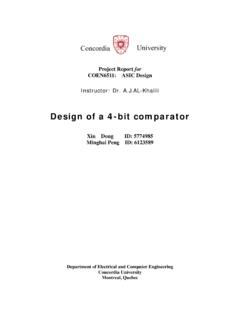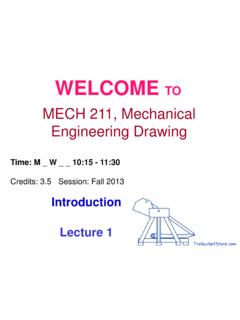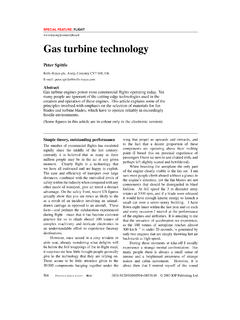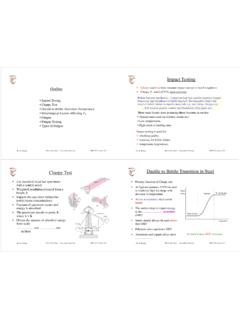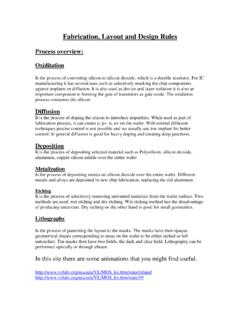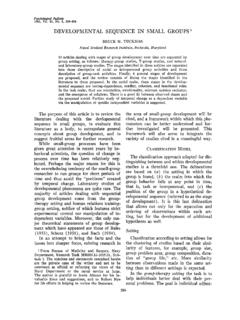Transcription of Chapter 4 FEEDBACK in AMPLIFIERS - Concordia University
1 Created by: Rabin Raut, 1 2/11/2012 Chapter 4 FEEDBACK in AMPLIFIERS (Review Appendix for background on two-port networks) FEEDBACK implies feeding back ( , returning back) a part of the processed signal to the input side so as to enhance or diminish the input signal. When the input signal (current or voltage) is diminished, it is considered as negative FEEDBACK . When the input signal is enhanced, it is known as positive FEEDBACK . Negative FEEDBACK is employed in amplifying systems to achieve certain special characteristics that are not obtainable from the basic amplifier. Positive FEEDBACK is employed to produce signal generator, such as oscillators.
2 In this Chapter we shall consider the case of negative FEEDBACK . The following topics will be covered: Basic concepts and benefits of negative FEEDBACK . Interconnections and associated circuit models of the amplifier and the FEEDBACK network. Analysis techniques with examples for the four basic amplifier configurations (VCVS,CCCS,VCCS,CCVS). Negative FEEDBACK and stability- phase and gain margins. 4. 1: Basic negative FEEDBACK system Consider the Figure below. The source signal could be a current or voltage. The basic amplifier has a gain A from left to right direction. A part of the output signal xo is fed back by the factor , from right to left, and subtracted (added with a phase inversion) from the input signal xs.
3 A sxfxox Figure : Basic negative FEEDBACK system Created by: Rabin Raut, 2 2/11/2012 While the basic amplifier has a gain A ( , xo /xI ), the overall gain of the FEEDBACK system xo /xs is Af which is A/(1 + A ). This gain is called the gain with FEEDBACK . The quantities A and Af could be any one of the four different kinds of function, , (a) voltage gain, (b) current gain, (c) trans-resistance gain and (d) trans-conductance gain. Some special features of the negative FEEDBACK system can be appreciated very easily. The quantity A is called the loop gain of the system. The term 1 + A is referred to as the FEEDBACK factor.
4 Exercise : An audio amplifier has a gain of 100 V/V. It is placed under negative FEEDBACK with a FEEDBACK gain (= ) of What will be the net gain now? (ans: 100/11) : Benefits of negative FEEDBACK : Gain de- sensitivity This implies that if there occurs a variation by certain amount in the gain A of the main amplifier, the gain Af of the FEEDBACK system is not altered as much , the gain variation is desensitized by negative FEEDBACK . Assume is constant. Then if we take differential of Af, we get 2)1( AdAdAf Thus it is evident that the variation dA in A has been reduced by the factor (1+A )2 because of negative FEEDBACK Exercise : Consider the amplifier in exercise Changes in the DC power supply may cause 20% variations in the gain of the amplifier.
5 What will be the variation if it is connected in negative FEEDBACK with = : Bandwidth extension This implies that if the band width of the gain A has certain values (say 1 MHz), by applying negative FEEDBACK , it can be increased. The increase, however, happens by sacrificing the value of the gain A. Thus, consider HMsAA 1 This has a high frequency band with of H rad/sec. If we apply negative FEEDBACK around the amplifier, the gain Af will become: Created by: Rabin Raut, 3 2/11/2012 )1(1)1()(1)()(HMHMfsAsAsAsAsA After simplification :HfMfMHMfMHMMfsAAsAAsAAsA 1)1(1)]1(/[1)1()( where, MMMfAAA 1, and )1( AHHf The above result implies a mid-band gain of AMf and a high frequency band width of Hf.
6 It can be clearly seen that the new mid-band gain is (1+A ) times smaller than the mid-band gain without FEEDBACK , but the high frequency band width is (1+A ) times larger than the band width without FEEDBACK . Thus an extension of band width by the factor (1+A ) has been achieved. Exercise : Consider the amplifier in exercise It has a bandwidth of 5 kHz. It is required to increase the bandwidth to 25 kHz. What value of should be used? What will be the new gain of the amplifier under FEEDBACK ? : Reduction of non-linear distortion in AMPLIFIERS It is known that most practical AMPLIFIERS have a non-linear output input transfer characteristics.
7 The non- linearity arises out of (i) non-linear response characteristic of the devices ( , transistors), and/or (ii) finite DC power supply values. A non-linear transfer curve represents a gain (~ slope of the graph) which varies depending upon the location of operation on the curve ( , the operating point). Thus one can define a series of gains, say, A1, A2, .. along the transfer characteristics. Under negative FEEDBACK the corresponding gains become A1/(1 + A1 ), A2/(1 + A2 ), and so on. If the loop gain values ( , A1 , A2 ) are very high ( , >>1), the FEEDBACK gain values approximate to 1/ in each case. Thus, the gains under negative FEEDBACK at different segments of the transfer characteristic appear to remain constant at a value 1/.
8 A constant gain (~constant slope) implies a linear curve, , a straight line. This is how the non-linearity in the response characteristic of the amplifier is reduced, and hence the attendant distortion gets reduced. Created by: Rabin Raut, 4 2/11/2012 4. 2: Interconnections for the negative FEEDBACK systems We will now consider the four distinct types of negative FEEDBACK connections and their respective characteristics as regards the overall gain, input and output impedances. The classification basically depends upon the four distinct types of AMPLIFIERS , namely, (a) voltage amplifier (VCVS), (b) current amplifier (CCCS), (c) trans-resistance amplifier (CCVS), and (d) trans-conductance amplifier (VCCS).
9 For each case, the topology ( , the style of interconnection) of the negative FEEDBACK network follows a regular pattern relative to the topology of the basic amplifier. Thus, for a voltage amplifier (VCVS), whose equivalent circuit model has (i) a series connection at the input through the input resistance, and (ii) a series connection at the output ( , the output controlled voltage source and its associated resistance connected in series), the FEEDBACK circuit will have (i) a series connection at the input, and (ii) a shunt (parallel) connection at the output. A rule of thumb is: the FEEDBACK connection at input matches with that of the basic amplifier, but the connection at the output is opposite to that of the basic amplifier.
10 : System diagrams for the FEEDBACK connections Consider figures 2(a)-(d) which depict the four possible interconnection styles (topology) around the four basic electronic amplifier systems. sRConnectionShuntsi+-sv fvsRBasicVCVSF eedback CircuitLRConnectionSeriesConnectionShunt ov+-sv fvsRBasicVCCSF eedback CircuitLRConnectionSeriesBasicCCCSF eedback CircuitLR ov(a)(b)(c)(d) oIConnectionSeriesConnectionSeries ov oIBasicCCVSF eedback CircuitLRConnectionShunt ovsRConnectionShuntsi Figure : Four possible FEEDBACK connections Created by: Rabin Raut, 5 2/11/2012 Quiz: Given a VCCS amplifier, what will be the topology of the FEEDBACK connections at the input and at the output?


